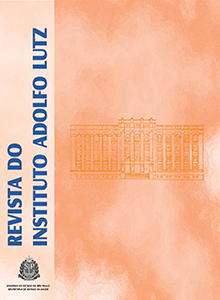Performance of liquid culture MGIT after implementation in a network of public laboratories of Sao Paulo state
Keywords:
tuberculosis, Mycobacterium tuberculosis, liquid culture, MGIT, cord factor
Abstract
In 2007, WHO recommended the implementation of liquid culture for tuberculosis (TB) diagnosis and drug-susceptibility test in low and middle-income countries. This study evaluated the performance of MGIT culture in routine condition after two years of its implementation in a public laboratories network. This is a retrospective study, which analyzed the data on the liquid culture performed in ten regional laboratories of the Institute Adolfo Lutz, from January to March 2010. The data included clinical samples submitted to microscopy, automated or manual MGIT culture and presumptive M. tuberculosis complex (MTBC) identification by analyzing the cord formation. Culture was positive in 1,159 samples. Of these, 113 (9.7%) contaminated, and 1,046 were analyzed, of which 850 (81.3%) were identified as MTBC, 116 (11.1%) as non-tuberculous mycobacteria and 6 (0.6%) as Nocardia sp. Contamination rate was 2.2% and the contribution of culture to the TB diagnosis was 29.9%. The detection mean time was 14.7 days (SD+/-11.7 days). The accuracy of the presumptive identification of MTBC was 91.3%. MGIT liquid culture demonstrated to be an excellent alternative for diagnosing TB and mycobacterioses, because of the rapidity of diagnosis, thus allowing an immediate and effective treatment.
Published
2017-01-01
How to Cite
Pedro, H. da S. P., Coelho, A. G. V., Nardi, S. M. T., Vilela, G., Silva, J. O., Nascimento, A. C. C., Galle, L. C., Aily, D. C. G., Ferro e Silva, R. R., Shikawa, M. de L. M., Leite, A. R., Suaiden, M. A. G., & Ferrazoli, L. (2017). Performance of liquid culture MGIT after implementation in a network of public laboratories of Sao Paulo state. Revista Do Instituto Adolfo Lutz, 76, 1-9. Retrieved from https://periodicoshomolog.saude.sp.gov.br/index.php/RIAL/article/view/33542
Issue
Section
ORIGINAL ARTICLE










